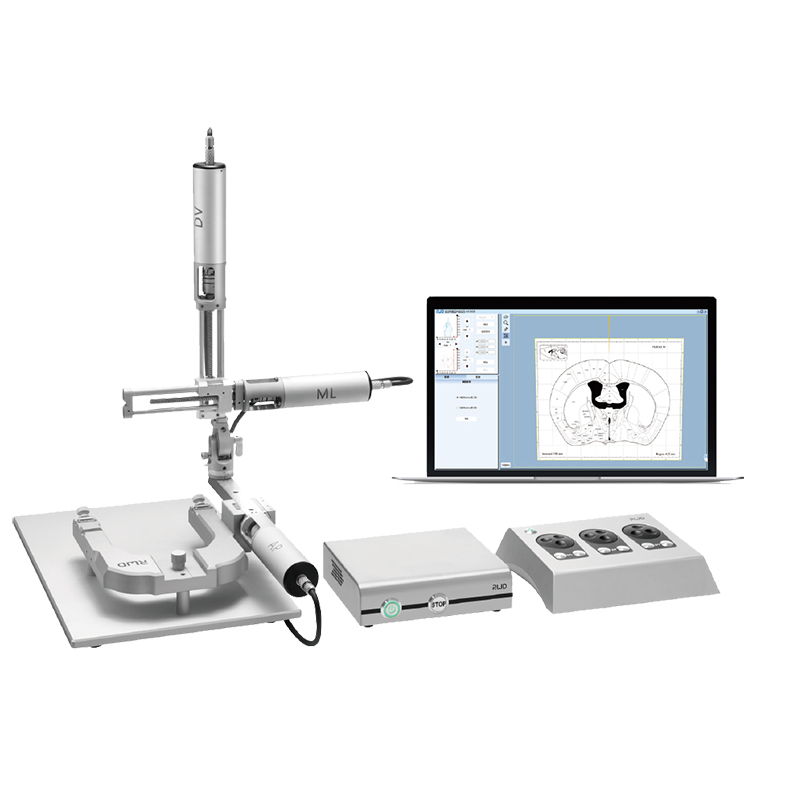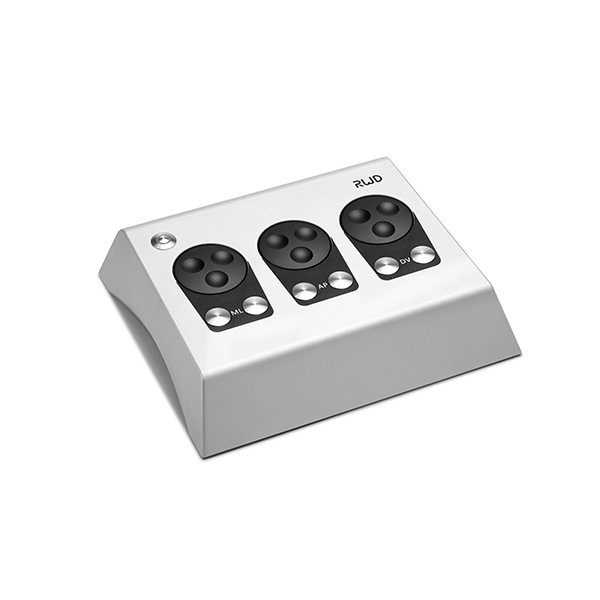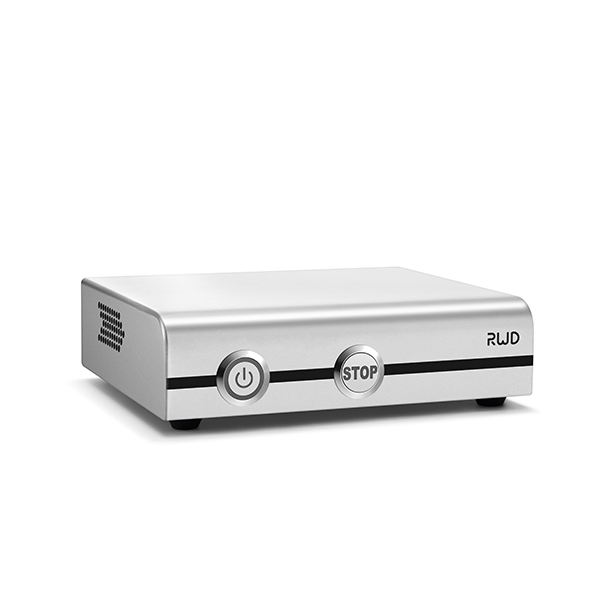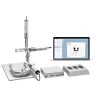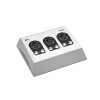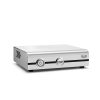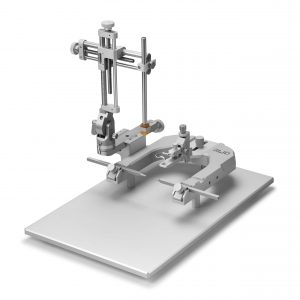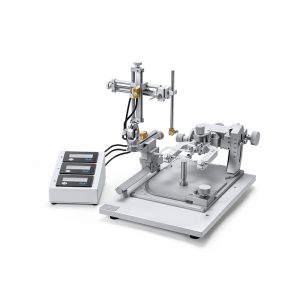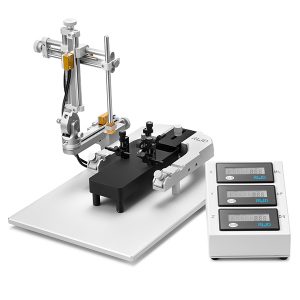Automated Stereotaxic Instrument
New automated (computer controlled) stereotaxic instrument from RWD offering precision (1μm), reliability, ease of use and improved safety.
Product Enquiry
If you would like to send us an enquiry about this product, please click the button below, fill in the form and submit.
Product Enquiry
The 71000 is the new automated intelligent (computer controlled) stereotaxic apparatus from RWD. Its high accuracy (1μm) ensures precise positioning. Researchers can observe the position of the probe relative to the brain area using the integrated atlas. Built-in software provides three automated procedures (skull window, tissue removal, and multi-point programs). The system is convenient, efficient, easy to operate, and can greatly reduce errors and damage caused by human operation. In addition, the motion collision prompt function prevents animal damage caused by mis-movement, therefore improving safety.
Key Benefits
-
- Integrated brain atlas of rats and mice and 3D display can help locate the target brain area quickly and accurately.
- Computer Control
- Brain Atlas Integration
- Intuitive Navigation
- Automated task program, like skull window program, tissue removal, and multi point program can meet various experimental need.
- Experiment Planning
- Avoids Human Errors
- Define/Store Targets
- High Throughput
- Set Bregma with one click, and 1 micron resolution.
-
- Bregma Setting
- Ultra-Precise
-
- Three control modes – PC software, Micromanipulator, and keyboard control are available.
- Convenient
- Time-Saving
- Integrated brain atlas of rats and mice and 3D display can help locate the target brain area quickly and accurately.
Features
-
-
- The operating arm moves up and down, left and right, and back and forth within a range of 80mm, with a high-precision screw, running accuracy of 1μm;
- One-key calibration function, when using for a long time, the computer display position parameters and locator reading deviation, the user can calibrate by one-key;
- Positioner movement control function, 4 control modes: a. PC terminal software interface arrow control; b. PC end automatically moves to the target coordinate after inputting the target coordinate position; c. The micro-operation platform can precisely control the positioner movement, micro-operation Every 18 ° rotation of the knob performs a displacement of 1 μm; d, keyboard keys control the movement of the locator.
- The locator movement speed adjustment function, a. The movement speed can be adjusted by inputting the movement speed at the corresponding positions of the three axes on the PC software interface. Among them, AP axis and ML axis can be selected from 5 movement speeds: 2.00 mm/s, 00 mm/s, 0.50 mm/s, 0.20 mm/s, 0.10 mm/s, 8 kinds of moving speed of DV axis can be selected 2.00 mm/s, 1.00 mm/s,、0.50 mm/s,0.20 mm/s, 0.10 mm/s, 0.05 mm/s, 0.01 mm/s, 0.005 mm/s, 0.001 mm/s; b. At the micro-operation end, the movement speed of the three axes can be uniformly adjusted by a certain step through the buttons;
- Set the Bregma / Lambda site with one click. When users use the locator to reach the Bregma / Lambda site, they can mark. One-click to set the Bregma / Lambda site;
- The coordinates of the locator are integrated with the brain map. The brain map version is the second version of the mouse and the sixth version of the rat. The user can select the brain map version. After selecting the version, the brain map version information is displayed;
- Probe position and brain map display, when the user finds and sets the Bregma / Lambda point, the computer interface can display the brain map and the location of the probe, and can display the movement process in real time;
- Automatic craniotomy program, 2 kinds of shape selection: square or round, length and width or diameter parameters (range: 0 ~ 20mm) and depth (range: 0 ~ 20mm), 5 kinds of moving speeds for AP axis and ML axis, 8 kinds of moving speed for DV axis;
- Multi-point program setting, the user can manually input or select up to 10 coordinates on the brain map, can choose automatic operation or start the operation after the signal is triggered, the user can set whether the locator outputs TTL signal after reaching the target point, The user can set the residence time at each location (range: 00:00:00 23:59:59);
- Tissue removal procedure, two shapes to choose: square or round, length and width or diameter parameters (range: 0 ~ 20mm) and depth (range: 0 ~ 20mm), support 2 needle specifications 27G, 30G, The density coefficient of 6 gradients is set from 1-6, and 5 kinds of moving speeds for AP axis and ML axis, 8 kinds of moving speed for DV axis;
- Position coordinate storage function, the user can manually input or select multiple coordinates on the brain map and name, can store up to 10 points;
- Z axis retraction function, when the user defines the Bregma / Lambda point, when the locator is moving in the X and Y directions, regardless of where the probe is located in the Z axis, the probe needs to be retracted first above the animal skull The position of 5mm on the surface ensures that the horizontal movement of the motor will not touch the skull of the animal;
- The choice of anti-backlash function can eliminate the error caused by the gap between the motor gears when the motor moves in the reverse direction. The user can choose to turn it on or off;
- Error log automatic saving function, convenient for product maintenance.
- The software requires adaptation to win7, win10 Chinese and English operating systems.
- Alarm function, real-time detection, stop all parts movement when encountering trouble, PC frame prompt;
- Ability to receive or output TTL signals, such as receiving TTL signals to trigger the automatic brain stereotaxic instrument to automatically move according to the set procedure, or output TTL signals when reaching a specific position;
- Micro-operation control, which can realize the continuous movement of the button of the handle to the full-automatic brain stereo locator.
- The control box has two kinds of power indicator lights, the normal state is green light, and the abnormal state is red light;
- The control box has 12V power interface, USB square port to communicate with the computer, 3 motor interfaces, there are silkscreen logos to distinguish, BNC interface that handles TTL signal.
-
Models
| Name | Cat No. | Components | Product Description |
| Automated Stereotaxic Instrument-Mice | 71000-M | 71000 | Automated Stereotaxic Instrument host (including U disk, dongle) |
| Control box (including power adapter, BNC data cable, 2m USB cable, grounding cable) | |||
| Micro operation (including BNC data cable) | |||
| 68055 | Mouse adapter | ||
| 68306 | Mouse 60 degree ear bar | ||
| Automated Stereotaxic Instrument-Rat | 71000-R | 71000 | Automated Stereotaxic Instrument host (including U disk, dongle) |
| Control box (including power adapter, BNC data cable, 2m USB cable, grounding cable) | |||
| Micro operation (including BNC data cable) | |||
| 68021 | Rat adapter | ||
| 68301 | Rat 18 degree ear bar | ||
| Automated Stereotaxic Instrument | 71000 | / | Automated Stereotaxic Instrument host (including U disk, dongle) |
| Control box (including power adapter, BNC data cable, 2m USB cable, grounding cable) | |||
| Micro operation (including BNC data cable) |
Optional Accessories
| Name | Cat No. | Components | Product Description |
| / | / | Needle connector | |
| 68202 | Large Probe Holder-6.0mm-12.0mm | ||
| GM-0.5B(220V,50HZ) | Vacuum pump-GM-0.5B-220V-50HZ | ||
| / | Liquid storage tank | ||
| / | Connecting pipe | ||
| / | Needle |
References
-
- Yang Y, Cui Y, Sang K, Dong Y, Ni Z, Ma S, Hu H. Ketamine blocks bursting in the lateral habenula to rapidly relieve depression. Nature. 2018 Feb 14;554(7692):317-322.
- Cui Y, Yang Y, Ni Z, Dong Y, Cai G, Foncelle A, Ma S, Sang K, Tang S, Li Y, Shen Y, Berry H, Wu S, Hu H. Astroglial Kir4.1 in the lateral habenula drives neuronal bursts in depression. Nature. 2018 Feb 14;554(7692):323-327.
- Zhou H, Xiong GJ, Jing L, Song NN, Pu DL, Tang X, He XB, Xu FQ, Huang JF, Li LJ, Richter-Levin G, Mao RR, Zhou QX, Ding YQ, Xu L. The interhemispheric CA1 circuit governs rapid generalisation but not fear memory. Nat Commun. 2017 Dec 19;8(1):2190.
- Huang L, Yuan T, Tan M, Xi Y, Hu Y, Tao Q, Zhao Z, Zheng J, Han Y, Xu F, Luo M, Sollars PJ, Pu M, Pickard GE, So KF, Ren C. A retinoraphe projection regulates serotonergic activity and looming-evoked defensive behaviour. Nat Commun. 2017 Mar 31;8:14908.
- Liu Y, Lai S, Ma W, Ke W, Zhang C, Liu S, Zhang Y, Pei F, Li S, Yi M, Shu Y, Shang Y, Liang J, Huang Z. CDYL suppresses epileptogenesis in mice through repression of axonal Nav1.6 sodium channel expression. Nat Commun. 2017 Aug 25;8(1):355.
- Wang GQ, Cen C, Li C, Cao S, Wang N, Zhou Z, Liu XM, Xu Y, Tian NX, Zhang Y, Wang J, Wang LP, Wang Y. Deactivation of excitatory neurons in the prelimbic cortex via Cdk5 promotes pain sensation and anxiety. Nat Commun. 2015 Jul 16;6:7660.
- Li WG, Liu MG, Deng S, Liu YM, Shang L, Ding J, Hsu TT, Jiang Q, Li Y, Li F, Zhu MX, Xu TL. ASIC1a regulates insular long-term depression and is required for the extinction of conditioned taste aversion. Nat Commun. 2016 Dec 7;7:13770.
- Hao X, Gu H, Chen C, Huang D, Zhao Y, Xie L, Zou Y, Shu HS, Zhang Y, He X, Lai X, Zhang X, Zhou BO, Zhang CC, Chen GQ, Yu Z, Yang Y, Zheng J. Metabolic Imaging Reveals a Unique Preference of Symmetric Cell Division and Homing of Leukemia-Initiating Cells in an Endosteal Niche. Cell Metab. 2019 Apr 2;29(4):950-965.
- Diao Y, Cui L, Chen Y, Burbridge TJ, Han W, Wirth B, Sestan N, Crair MC, Zhang J. Reciprocal Connections Between Cortex and Thalamus Contribute to Retinal Axon Targeting to Dorsal Lateral Geniculate Nucleus. Cereb Cortex. 2018 Apr 1;28(4):1168-1182.
- Chen X, Guo Y, Feng J, Liao Z, Li X, Wang H, Li X, He J. Encoding and retrieval of artificial visuoauditory memory traces in the auditory cortex requires the entorhinal cortex. J Neurosci. 2013 Jun 12;33(24):9963-74.

